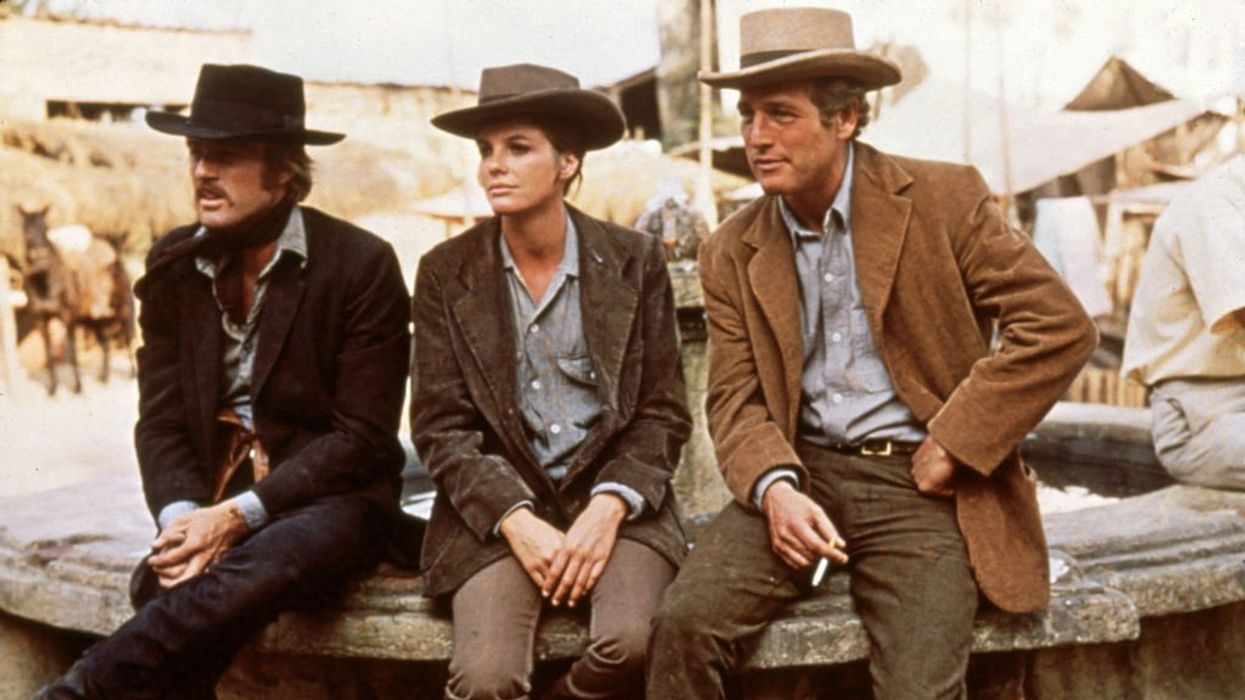
Getty Images/United Archives

Newman and Redford broke the John Wayne mold with a pair of bickering, wisecracking outlaws staying one step ahead of the law.
America has always been wild. Probably always will be. A land of liberty and violence. We are a deeply rebellious country. As such, we have a soft spot for outlaws.
The real Butch Cassidy and the Sundance Kid, for example, were generally embraced by the public.
Cassidy’s Wild Bunch belonged to the coalition of outlaws known as the Hole-in-the-Wall Gang, who stole horses and robbed banks, among other crimes, then retreated to the Hole-in-the-Wall Pass in Wyoming, a safe haven for men who won’t, or can’t, be tamed.
We Americans love that spirit. To be wild requires a certain lack of propriety. Civilized people don’t fight their way across a monstrous continent.
Butch Cassidy, by most accounts, was gifted with charm and charisma. But that's not why people loved him. They loved him because he was wild.
It's hard to separate fact from fiction when it comes to much Old West lore, and Cassidy is no exception.
So "Butch Cassidy and the Sundance Kid" opens with a disclaimer: “Most of what follows is true.”
"Butch Cassidy and the Sundance Kid" was written by William Goldman, who went on to write "All the President’s Men" and both the novel and film "The Princess Bride."
Studios didn’t want the script. They demanded that Goldman rewrite it so that Butch and Sundance didn’t flee to South America.
When Goldman told a studio executive that the real-life Butch Cassidy and the Sundance Kid fled to South America, he replied, "I don't give a sh**. All I know is John Wayne don't run away."
For a film about a conglomerate of outlaws all vying for kingship, it is incredibly relaxing and enjoyable — funny, but in a calm, lovely way.
Part of this is the scenery. Filming took place in the mountainous Eden of southwest Utah, including a national park and a ghost town. It is an earthly paradise. You can feel its grandeur through the screen.
In my recent interview with film historian Andrew Patrick Nelson, he placed "Butch Cassidy and the Sundance Kid" on his list of the four underrated Westerns that everyone should watch. He also described the unique social, political, and cultural setting of 1969 and how it shaped cinema.
The movie lives and dies with the chemistry of its two stars, Paul Newman (Butch Cassidy) and Robert Redford (the Sundance Kid).
Midway through his 40s at the time, Newman was riding the success of his previous film, "Cool Hand Luke," which was produced by Jack Lemmon, who was originally offered the role of Butch Cassidy but declined because he didn’t want to get stuck on horses.
Before that, Newman was in "Torn Curtain," a Cold War spy thriller by Alfred Hitchcock. Newman had started his career opposite Elizabeth Taylor in "Cat on a Hot Tin Roof," based on Tennessee Williams' Pulitzer-winning play. The performance earned Newman an Oscar nomination.
Redford was 33 at the time, and his career had yet to take off. His appearance in "Butch Cassidy and the Sundance Kid" changed that. He’s even kept the title “Sundance,” using it for his creative and business endeavors.
Newman and Redford are magical together. Everything they do is so natural. It’s like you’re watching a true story take place in real time.
"Butch Cassidy and the Sundance Kid" took a beating from the critics at first. Roger Ebert called it "slow and disappointing."
Audiences disagreed. By the end of 1969, "Butch Cassidy and the Sundance Kid" was the highest-grossing movie of the year.
It earned seven Oscar nominations at the 42nd Academy Awards, the same year John Wayne won Best Actor for his role as Rooster Cogburn in "True Grit." Best Picture and Best Director went to "Midnight Cowboy," although "Butch Cassidy and the Sundance Kid" won Best Original Screenplay, Best Cinematography, and Best Soundtrack.
It also won Best Song, for Burt Bacharach's classic “Raindrops Keep Fallin' on My Head."
"Butch Cassidy and the Sundance Kid" has since been inducted into the National Film Registry, and in 2008, the American Film Institute ranked it the seventh-greatest movie in the category of Western. The Writer’s Guild of America placed it 11th on its list of the 101 all-time Greatest Screenplays.
In the life of the outlaw, everything is upside down.
At one point, Butch Cassidy, half-caring, says: “Every day you get older: That’s a law.”
Both men show us a range of emotions. It’s not strange to see the outlaws depressed. Other times, they rattle on about minutiae.
Even when he’s annoyed, Newman is cool; Redford is serene, even when holding a woman at gunpoint.
They basically just make their way from place to place, occasionally sprucing up with a tuxedo, with tons of bickering, flip-outs, and short fuses, only to whip back to carefree when fleeing from the law.
Their frustration is a large part of the comedy, as well as the bandito’s cycle: plot, then rob, then escape, then run for dear life, then celebrate, briefly, before the next robbery.
But is there actually freedom in this cycle? Or is it a rebellion that only deepens the confinement, a life of unending escape? Should we desire to have the outcast’s independence?
Sundance Kid, laughing: “You just keep thinking; that’s what you’re good at.”
Butch Cassidy, shaking his head: “Boy, I’ve got vision and the rest of the world wears bifocals.”